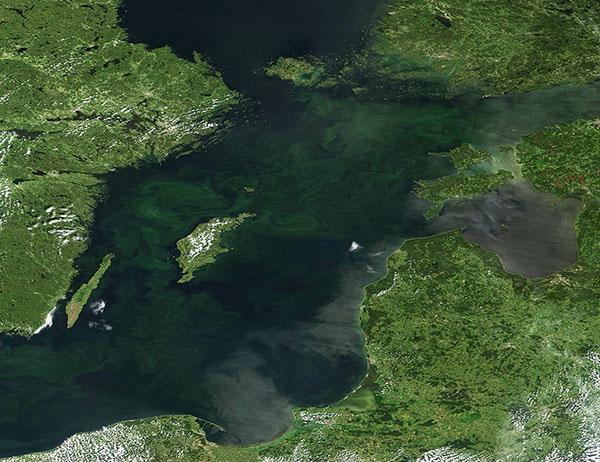Images
June 29, 2024 - Blooming Baltic Sea
Tweet
Sediment and phytoplankton colored the waters of the Baltic Sea in early summer 2024. The Moderate Resolution Imaging Spectroradiometer (MODIS) on NASA’s Terra satellite acquired a true-color image of the swirling scene on June 25.
The tan tones along the eastern shore are most likely sediment floating near the surface of the water. It may have been swept into the Baltic from runoff from land or carried into it by rivers. The green swirls, however, are typical of blooms of phytoplankton. Derived from the Greek words phyto (plant) and plankton (made to wander or drift), phytoplankton are microscopic organisms that live in watery environments, both salty and fresh. It’s a wide group, containing bacteria, protists, and single-celled plants.
While it’s not possible to determine what species is blooming just by viewing from space, the Baltic Sea usually hosts large numbers of cyanobacteria, which bloom when water is warm in late spring or summer. Also called “blue-green algae”, some types of cyanobacteria can produce microcystin, a potent toxin that can irritate the skin and cause liver and kidney damage in people and animals.
Image Facts
Satellite:
Terra
Date Acquired: 6/25/2024
Resolutions:
1km (308.8 KB), 500m (800.6 KB), 250m (1.9 MB)
Bands Used: 1,4,3
Image Credit:
MODIS Land Rapid Response Team, NASA GSFC
Tweet
Sediment and phytoplankton colored the waters of the Baltic Sea in early summer 2024. The Moderate Resolution Imaging Spectroradiometer (MODIS) on NASA’s Terra satellite acquired a true-color image of the swirling scene on June 25.
The tan tones along the eastern shore are most likely sediment floating near the surface of the water. It may have been swept into the Baltic from runoff from land or carried into it by rivers. The green swirls, however, are typical of blooms of phytoplankton. Derived from the Greek words phyto (plant) and plankton (made to wander or drift), phytoplankton are microscopic organisms that live in watery environments, both salty and fresh. It’s a wide group, containing bacteria, protists, and single-celled plants.
While it’s not possible to determine what species is blooming just by viewing from space, the Baltic Sea usually hosts large numbers of cyanobacteria, which bloom when water is warm in late spring or summer. Also called “blue-green algae”, some types of cyanobacteria can produce microcystin, a potent toxin that can irritate the skin and cause liver and kidney damage in people and animals.
Image Facts
Satellite:
Terra
Date Acquired: 6/25/2024
Resolutions:
1km (308.8 KB), 500m (800.6 KB), 250m (1.9 MB)
Bands Used: 1,4,3
Image Credit:
MODIS Land Rapid Response Team, NASA GSFC




